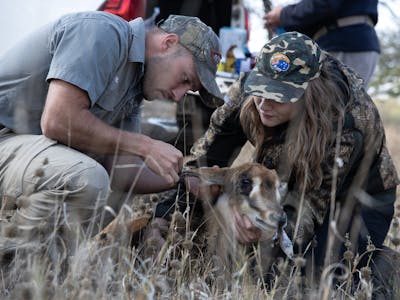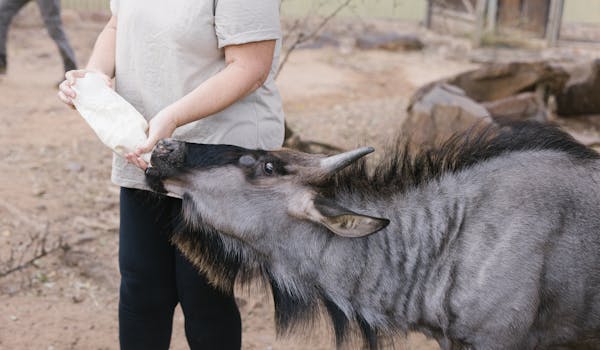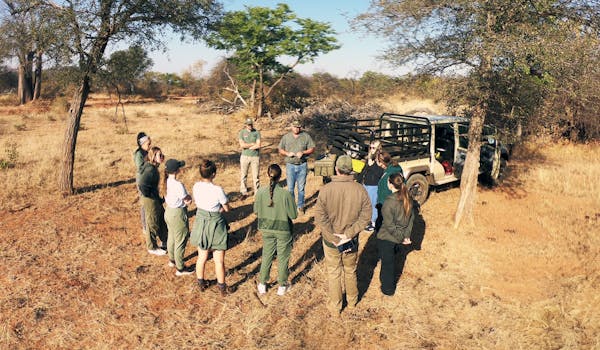Make it yours
Every experience is customised to be just right for you.

Our Veterinary Placement for EMS Students gives you the chance to shadow, assist and observe the daily operations of experienced wildlife veterinarians working in one of Africa’s most ecologically diverse regions - all while recording tracked hours to meet your university’s EMS criteria.
Placement opportunities are tailored to align with your academic interests and career goals. You’ll be paired with a veterinary team based on your goals where possible, to help you gain relevant exposure to field and clinical skills.
Throughout your placement, you will observe and assist a range of veterinary procedures involving a variety of African species. These may include darting protocols, chemical immobilisation, translocation efforts, disease monitoring, and reproductive health assessments. All taking place in dynamic environments that often demand adaptability and clinical reasoning.



This placement meets the Extra Mural Studies (EMS) requirements for veterinary undergraduate degree programmes. You’ll gain verified tracked hours under the supervision of qualified veterinarians.
You’ll work in small cohorts (typically 2–4 participants), ensuring direct engagement with some of Africa’s leading wildlife veterinarians. This structure allows for a highly personalised and immersive clinical experience.
You’ll gain exposure to a diverse range of animals - enhancing your understanding of species-specific care. You’ll also observe and assist in the diagnosis, treatment and management of various conditions, furthering your knowledge of regional pathology.
Depending on the case and your level of experience, you may assist with procedures including wound management, surgical interventions, sterilisation, diagnostic testing and disease management of notifiable diseases.
Depending on the cases at the time, you may support expert vets working on large mammals that have been chemically immobilised. Under close supervision, you could help monitor vital signs, collect samples, assist with treatment, and prepare the animal for recovery.
Veterinarians play a vital role in supporting wildlife conservation through disease control, population management, and maintaining genetic diversity. Via your placement, you’ll contribute to the long-term viability of threatened species.
All procedures are medically necessary and aligned with best-practice ethical standards. The programme does not conduct procedures solely for training purposes. Interventions such as rhino horn trimming are performed only when they are in the animal’s best interest.
Fieldwork involves travel across multiple reserves, offering you the chance to discover varied ecosystems. You’ll also gain insight into rural African communities and the cultural context in which veterinary services are delivered.
In addition to practical experience, you’ll benefit from in-field instruction on topics such as wildlife physiology, pharmacology, anaesthetic risks (including stress-related mortality), capture techniques, chemical and physical restraint, translocation protocols and endemic disease profiles.
Your contributions directly fund veterinary services that would otherwise be inaccessible to local communities. This includes parasite management, treatment of injuries, and disease prevention programmes - extending the impact of your placement beyond your direct casework.
You’ll join a real veterinarian on their day-to-day casework. What you’ll do depends on which animals are being treated at the time, what kind of care they need, and your level of experience. Because this is a real veterinary environment and not set up for tourism, the work depends on what cases arise. Your veterinary priorities will include a range of the following activities.
You will get to experience veterinary procedures in the field. You could observe or assist:
You will get to experience a variety of veterinary procedures in a large clinic. You could observe or assist:
You will get to experience practical conservation in the field during veterinary field clinical procedures. You could observe or assist:
Depending on the needs of the team during your stay, mass wildlife capture work could take place. When it happens, you could get to observe or assist:
You’ll learn about wildlife behaviour, biology and veterinary care, as well as broader conservation issues. Depending on the animals being treated, this will include a range of the following topics.
This project contributes to a variety of the UN’s Sustainable Development Goals. As part of the team, so will you.

By offering paid student opportunities, the vets leading the EMS Placement attract international funding that provides a means for the vets to treat sick and injured animals and provide pro bono work to underprivileged communities.

All participants on the EMS Placement acquire knowledge of veterinary work, how human actions can affect wildlife and how they can minimise this effect - and have access to the same standard of education regardless of sex and background.

The vets leading the EMS Placement provide equal employment opportunities for local women and men and equal studying opportunities for women and men outside the local community.

The vets leading the EMS Placement routinely employ young people between 15 and 24 and provide equal employment opportunities for local men and women. Participants provide both economic and physical support, facilitating important conservation work and education within the local community.

The vet practices are built sustainably and resiliently using materials that are locally sourced from within South Africa. The project also protects natural heritage through the conservation of iconic African species.

The vets leading the EMS Placement promote responsible tourism in a variety of ways: through the creation of local jobs; by educating international visitors how to live in harmony with nature; and in their vital conservation work.

The vets leading the EMS Placement take significant action to halt the loss of biodiversity and prevent the extinction of threatened species. Through their involvement in anti-poaching strategies, wildlife disease management, and maintaining genetic diversity in wildlife populations, they play a powerful role in preventing the degradation of South Africa’s natural ecosystems.
The project also takes urgent action to prevent poaching by trimming rhino horns - an effective deterrent when combined with other wildlife management practices.
By offering paid student opportunities, the project increases its financial resources, enabling it to conduct wildlife relocation work, which is key for the conservation of threatened species.

The vets leading the EMS Placement carry out rhino horn trimming procedures where they remove the exposed portion of the horn. Combined with other wildlife management measures, horn trimming deters poachers and reduces the unethical practices associated with their activities.

Through the vets’ partnership with us, they draw in financial resources that are used to fund conservation and provide support to their community partners in South Africa.
Related experiences
Explore programs similar to this one.

Engage in real wildlife veterinary work in the field and clinic, then provide hands-on care for orphaned and injured animals
View details for The Clinic To Care Experience
Experience wildlife veterinary work inside a busy clinic, a specialist sanctuary, and the open savannah
View details for The Savannah Veterinary Explorer